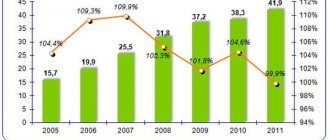Beginning entrepreneurs strive to organize their own business in such a way that it gives the desired profit and brings pleasure. Beekeeping as a business is a common activity. It can really become a source of good income if the work is organized correctly and the existing risks are taken into account. Many are interested in this type of activity, but they are frightened by the lack of knowledge, information and skills in the field of insect breeding. In practice, keeping bees is not troublesome, but there are certain subtleties and features.
Before you start organizing beekeeping, decide how much you are willing to invest in the development of the business, and what income you plan to receive. Keep in mind that insects do not produce honey all year round. The food collection season lasts six months.
Advantages and disadvantages of beekeeping
Like any type of activity, beekeeping has its advantages and disadvantages.
Advantages
- Profitability of beekeeping. You can earn income in the first year of entrepreneurship. Rationally planned costs will cover the initial investment. It is not necessary to purchase new equipment and tools for organizing an apiary. The type of activity does not require rent for space, premises and equipment. Practice shows that for beginning businessmen the costs are recouped within 2 years, for experts in beekeeping with experience - in the first season.
- The beekeeping business does not require hired workers. The beekeeper is the only worker. This significantly reduces staff wage costs. Profits from the sale of products are used to expand the business and pay taxes.
- Possibility to organize a business in several stages. You can invest money in development and expand your business gradually, not all at once.
- No special education or courses required. There are many videos and topical material on social networks for beginners and experienced beekeepers.
- An apiary as a business can exist as an additional source of income and is easily combined with the main activity.
- Honey and other bee products are obtained without much effort. The beekeeper does not need to spend a lot of time and effort caring for insects. Their existence does not depend on human activity.
- The price of the inventory and equipment necessary to make honey is relatively low .
Flaws
- The high cost of honey. The cost of a natural product is quite high, so it is quite difficult to form a customer base.
- High competition.
- Unfavorable climatic conditions. Rainy weather, cold, damp climate in Russia negatively affect the life of bees. The volume of production is decreasing.
- Bee diseases.
- Lack of environmentally friendly areas for beekeeping.
- The presence of allergic manifestations to insect bites and their metabolic products.
Is it profitable to engage in beekeeping?
There are several ways to keep bees at home. To understand whether this undertaking is profitable, you need to consider all the options.
The majority of beekeepers are private owners who breed bees. Their apiary consists of dozens of bee families. This kind of farming is probably beneficial for business. The apiary is on territory that the beekeeper already owns, so the benefits from such farms are greater than the costs.
Positive aspects of small business:
- No rent;
- Minimum labor costs;
- Sales in small quantities through the retail network.
More than five hundred bee colonies are available at mid-level beekeeping farms. For them, retail sales of honey products are not enough. Such farms have to establish wholesale distribution channels, which is more profitable. Costs also increase accordingly. You will have to spend money on rent and on hired workers.
There are few industrial apiaries. Such holdings of 2.5 thousand bee colonies constitute the agricultural production sector. For example, in parallel, an enterprise can grow cereal crops. Integrated farming also provides corresponding profits. But the expense item is also not small.
In the honey market, the main niche is occupied by private apiaries. Making possible calculations, it turns out that the bee business brings obvious benefits. In addition to honey itself, entrepreneurs sell propolis, wax and other honey products.
Important!
Additional income can be received from excursions around the apiary and filming video tutorials.
Wholesalers working with honey products do not skimp on prices and offer favorable conditions and often buy the batch immediately. Therefore, speaking about beekeeping as a business, it can be argued that with proper organization of the apiary, a constant increase in sales is guaranteed.
First costs
Before starting a bee business , make calculations and assess your financial capabilities. To understand what bee farming is and what costs it will entail, you need to draw up a business plan.
To start your entrepreneurial journey, you need to purchase at least 5 insect families. If funds allow, then it is better to buy 10 families, then the profit from the new apiary will more likely cover the costs. All necessary equipment must be purchased along with the insects.
The list of attributes and costs are given in the table.
| Name | Quantitative measure | Price in dollars |
| insect family | 10 | 1200 |
| Bee houses | 10 | 630 |
| Sushi | 50 | 190 |
| wax | 5 kilograms | 50 |
| Framework | 50 | 65 |
| Tin cans capacity 40–50 liters | 2 | 120 |
| Containers, plastic buckets | 10 | 30 |
| Honey extractor | 1 | 270 |
| Face protection net | 1 | 8 |
| Smoker | 1 | 13 |
| Wax melter | 1 | 70 |
| Stainless steel wire spool | 1 | 12 |
| total amount | 2658 |
The costs are given taking into account the fact that the territory on which the businessman will place the apiary is available. Having received the amount of initial costs, many people wonder whether it is profitable to engage in this business?
To reduce costs, you can make a wax melter yourself, purchase a new honey extractor, and use food storage containers instead of cans.
Methods of selling and exporting honey
The method of sale plays a crucial role in the profitability of starting a bee business. The best financial results are achieved by direct sale of honey. The prices offered by the companies that buy it are halved, which calls into question the profitability of maintaining an apiary.
When creating a beekeeping farm, it is necessary to take into account that it takes at least several years to build a direct sales market. Apiaries that have developed a so-called brand have less difficulty selling. Regular clients report to them themselves.
Place for an apiary
The apiary must be located in the village. Choose a place away from the highway and human settlements, preferably close to a reservoir. The hives are installed on stands. Place drinking bowls if there is no body of water nearby. There should be fields with honey-bearing vegetation around, flowers from which you can collect pollen.
To clearly see an example of the area and hear expert advice, watch the video.
Having chosen the optimal location, the beekeeper must notify the farm and forestry on whose territory the selected zone is located. Ideally, the apiary will change locations several times during the season. Rationally selected locations will increase production volume by 30–40% and income from the apiary will increase. It is better to place bee houses close to trees. They protect from scorching sun rays and wind. The hives are arranged in a checkerboard position, or in a linear order. The distance between the rows is 2–3 meters, the distance between the houses is 3–5 meters.
Risk assessment according to the business plan
Risks in honey production and how to avoid them:
The bees did not overwinter well due to various external factors, as well as poor feeding. Possibly insufficient heating or poor feed composition. This can be avoided if you carefully prepare for winter, feed the bees with high-quality food and on time.
- Infection with diseases, spread of epidemic. Such a risk does not threaten if sick individuals are identified in time, treated and prevented from spreading diseases en masse. It is worth following the recommendations on their contents and taking into account sanitary and epidemiological standards when caring.
- A bad year in terms of weather conditions creates a risk of poor flowering of plants and poor honey harvest. Migratory migration is a way to avoid such troubles and expands the possibility of using honey plantations. Disruption of product sales. It can be prevented through careful study of sales markets. Conducting regional marketing research. Increasing the number of regular customers and wholesale sales.
- The onset of unforeseen situations: fires, arson, damage and theft of property. Insurance will compensate for losses in such situations. You just need to carefully describe the situations for compensation of damage.
- A mistake when transporting bee families is steaming. If you carefully prepare for movements and use nets for migration, then the situation will not arise and the transportation will go smoothly.
When a person decides to open a business from scratch, he first of all considers those areas that will be interesting to him. Then he figures out the financial component of this matter. And it is important to combine caring for bee families with the benefits of financial investments.
Purchase of bees and equipment
The business plan of a novice beekeeper starts with the acquisition of insects.
Purchasing Tips
- The purchase is made in mid-April - early May.
- The minimum number of families is 5. Ask what breed of bees and how much honey they produce per season.
- Buying families together with houses is profitable.
- Buy insects from an experienced, successful beekeeper.
- The colony must have a queen and brood.
In beekeeping, a beekeeper must have:
– stands for hives,
– wooden frames;
– uniforms;
– beekeeper’s kit (smoker, brush, knife, chisel);
- honey extractor.
What is required to organize beekeeping?
When preparing to open his own business, a novice beekeeper often thinks about what an apiary cannot exist without.
Here is a list of the key elements of beekeeping:
- Hive . To begin with, it is worth studying, focusing on other beekeepers, which hive designs prevail in your area. It is not recommended to come up with something new at the first stage, since a lot of problems may arise.
- Bee family . Choosing bees is a crucial moment and it is best to purchase a bee colony for the first time from a familiar beekeeper. If this is not the case, then you can only rely on yourself. When choosing bees, pay attention to the uniformity of seeding of the frame. Elite families have them completely sown. Bees' wings should not be frayed. There should be no dirty white lumps at the bottom of the hive, indicating a disease such as ascopherosis.
- Workwear . To work with bees, you will need a protective suit in the form of overalls and a wide-brimmed hat that is wrapped in mesh. The beekeeper's clothing should always be clean and tidy.
- Diaphragm and grille . The diaphragm divides the hive into two zones when replanting young bees. The lattice isolates the uterus from the cases.
- Smoker . Allows you to calm the bees before starting work. It is impossible to work with some breeds of bees without using smoke at all.
- Chisel . With its help, they lift the bodies and other parts of the hive when working with a bee colony.
- Frames . Frames are needed to build cells. 5-6 rows of wire are pulled through them.
- wax . Used for the construction of honeycombs.
- Honeycomb printing tool . A fork can be used for these purposes.
- Honey extractor . Allows you to collect honey from honeycombs without harming the bees.
- Pollen catcher . It sucks up pollen from the tray that flies off the bee's legs after it flies through the grate.
Registration and taxes
A business plan for breeding bees includes paperwork and payment of taxes. To officially do what you love, declare it to the tax office and register as an entrepreneur. To do this, select the optimal cipher: 01/49/11, 01/49/12, 1/49/13. When applying for status, a national fee is paid and a taxation system is selected. The best option for beekeeping is a single tax. The tax rate is fixed and does not change depending on the size of profit.
It is required to obtain a passport for the apiary and contact veterinary control specialists. They check insects for diseases. In the absence of diseases, the veterinary service issues a document allowing bees to be raised, collected and sold.
How to start a beekeeping business
Beekeeping as a business requires organization. A beekeeper must understand where to start a business and how to succeed in it. To do this, you need to build a chain of actions step by step. The most necessary thing in the first stages will be to find a spacious area and organize it for an apiary, purchase healthy bee colonies, warm hives, as well as the necessary equipment. The second main step will be to register your own business selling honey and other beekeeping products.
Paperwork
To register a beekeeping farm, you need to register a peasant farm. This is if all activities are carried out on the beekeeper’s territory and without hired workers. In this state of affairs, the farm is not subject to tax.
To carry out sales, the following documents must be completed:
- Veterinary passport. It indicates the farm’s compliance with sanitary and hygienic standards;
- Certificate of honey quality;
- Veterinary opinion;
- Information about the number of apiaries.
With this set of documents, the beekeeper can sell honey at fairs and among friends.
Important!
If you want to sell products in markets, through retail outlets and rented stores, you will need to register an individual entrepreneur. Now you will need to pay taxes, for example a single tax on imputed income.
Finding a place for an apiary
It is important to choose the right place for the apiary. At the very beginning of a business career, it is your own plot of land, located closer to the fruit trees. Better without drafts. Bees prefer cherry, acacia and linden. Flowers include clover and buckwheat. This place should be fenced so that the bees do not cause trouble for the neighbors.
If the beekeeper has the funds to rent, then it is better to choose a place near the fields where honey plants grow. This, of course, will increase honey collection and improve quality.
The size of the territory must ensure the quality of work. For 2 bee colonies there should be 100 sq. m. The hives are staggered so that the bees do not get confused. It is advisable to have a wind protection tree nearby. It is more correct to provide a distance of 5 m between each hive, and 4 m between rows.
Purchase of inventory
The expense item in a beekeeping business plan is the purchase of necessary equipment. Profitable work is structured clearly and competently. So, the necessary equipment includes:
- Vertical hives made of wood with frames;
- Portable frame boxes;
- Special protective clothing and face net;
- Honey extractor;
- Smoker;
- Cells for containing queen cells;
- Feeders;
- Wax melter;
- Table for printing honeycombs;
- A sieve for straining honey.
Purchasing bees
Choosing bees is difficult for beginners. It is better to buy bees in the local climate zone. These are accustomed to the weather. Purchasing from local experienced beekeepers gives you the opportunity to get healthy colonies and you can hear advice on breeding and ask questions.
Experienced beekeepers recommend the Central Russian and Carpathian breeds of bees. These insects are not so aggressive, peaceful and will not harm either the owner or neighbors.
Bees for the apiary are bought in “hundreds of frames”. These are special bee bags. Each of them contains working bees in a printed solution. Young working insects are also constantly born there. The kit includes one queen and 15,000 worker bees.
When checking the quality, you need to carefully examine the frames and make sure that there is a uterus and that there is no waste. Podmor can be from 15 insects.
You need to check the bottom, you can find traces of ascopherosis there. If lumps of gray-white color are found at the bottom, then it is better not to buy such a family.
Marketing and sales
A beekeeping business plan includes finding buyers.
Beekeeping products that can be sold, market value:
– honey – $10 kilogram;
– propolis – $8 per 100 grams;
– beebread -$33 per 100 grams;
– bee venom – $9 per 100 grams;
– royal jelly – $15 per 100 grams;
– wax – $6 100 grams.
An apiary can be profitable if you use several ways of implementation.
- Market.
To sell products on the market, you must have a passport for the location of bee houses and a certificate of product quality. The owner and his family members are allowed to engage in trade. A chance to sell more products, increase income from your apiary in a market with high traffic.
- Honey fairs.
Beekeepers earn money at honey fairs, where they sell their products and join the ranks of regular customers.
- Sales for sale to wholesalers.
The cost is lower than the market price, but the volume of goods sold increases significantly.
- Through announcements in local and regional press, social networks.
- Creation of a virtual store where you can order beekeeping products.
- Give royal jelly to beauty salons.
- Bee venom is in demand among specialists in alternative medicine.
- Wax is the raw material for making foundation, which is in demand among other beekeepers.
Business and product description
Honey is a healthy, tasty product used for food, medicinal and cosmetic purposes. Demand for it is stable throughout the year, but increases at the beginning of the honey harvest season (May-September). It is produced by hardworking insects - bees.
To achieve consistently high production rates, a number of conditions are needed: timely feeding, protection from diseases, insulation of hives, a marketing plan and the necessary equipment.
In the last 10 years, private beekeeping has been on the rise. The development of social networks and other Internet resources helps to find buyers without resellers and deliver honey to any region.
Previously, due to the difficulties of finding buyers, beekeeping for many beekeepers was akin to a hobby or a way to provide a sweet product for their family members rather than a source of stable income.
The average honey consumption per capita in Russia is 650 grams per year. For comparison: in Germany - 4.5 kg per year. The Russian market is ready to accept 7 times more products compared to 2017-2018.
Risks
Beekeeping as a business has risks.
Existing problems:
- Unfavorable climate reduces beekeeping production.
- Insect diseases.
- Lack of environmentally safe areas.
- High competition, difficulty in forming a client base.
- It is difficult to study without a basic understanding of the life activity of bees.
During the first few years, beekeepers note that the business plan drawn up for a beekeeping farm cannot always be implemented. Unplanned costs arise in the form of diseases, the need to purchase means for transporting bee houses, ensuring the safety of the insect population in the winter, etc.
Beekeeping as a business reviews
Opinions about beekeeping vary. Mostly positive. An entrepreneur from Arkhangelsk wanted to follow the example of his older brother to breed bees, but he serves as a distributor of honey products. The climate of his place of residence is not suitable for beekeeping.
A beekeeper from Krasnodar says that he wanted to start a private honey farm. The initial goal was to have enough honey for the family, relatives and friends. And then I got involved: from three families I moved to six and so on. The rise to profitability prompted expansion.
The likelihood that you can build a profitable business in beekeeping is high. After all, they register a business already having a ready-made apiary. And it doesn’t require large starting investments. The joyful moment was that you can count on receiving income by the beginning of the next season after the starting season.
Increased profits
Is it profitable to be a bee? Experienced beekeepers note the tangible benefits of beekeeping with established activities. For a novice businessman, an apiary for 10 hives will be enough. In a year, it will fully cover all costs and return the invested funds. The profit of a newly minted beekeeper increases over time and allows him to expand the scale of his activity. You can increase your holdings by 10 bee families per year.
A successful business is considered for beekeepers who own a farm with 50 hives. The annual income from honey sales alone is approximately $5,000. If you use other bee products and sell them, then add another 40–50% to the income received.
If there are 150, 200, 300 or more bee colonies in the property, this is entrepreneurship on a production scale. You won't be able to handle the organization alone.
Difficulties of running an apiary business
A common mistake young beekeepers make is that after the first attempts to collect honey, all enthusiasm ends. It is good for any beekeeper to be prepared for the fact that an apiary just created will not bring much money in the first year.
Beekeeping is a business like any other and you must be aware of the fact that it takes time to get the results you want.
A common mistake young entrepreneurs make is not testing for allergens.
Before you start working with bees, check your body for any allergic reaction to honey and bees; beekeeping may be a dangerous job for your health.
My business today
My business is now thriving and making good money. Thanks for this to my uncle and me, of course, because I put a lot of work into this matter.
The season is not over yet, but I already pumped honey once and sold it all. I earned 90,000 rubles for the first time. And, to be honest, I already spent it - I bought a new greenhouse for my wife.
So, I work and earn money, and do not stand still. I bought three more hives, each with 14 frames. A family of bees has already moved into one hive.
I intend to continue and grow my business.
I will move forward: I want to hire two workers for my apiary to help me. And also, I was offered to supply honey to St. Petersburg for sale. I'm still thinking.
In principle, I’m good at selling honey here too, but its price is simply increasing there, and a liter of honey will cost not 300 rubles, but 400. Honey will be sold in three-liter jars. One jar will cost 1,200 rubles, and I sell such a jar for 900 rubles. I’ll probably still agree and we’ll sign a contract.
How much can you earn from an apiary?
From such an apiary in one season in the conditions of the middle zone you can get up to 50 kg of honey from one bee colony. Accordingly, with 100 bee colonies – 5000 kg (5t). The wholesale price for honey as of 2020 is a minimum of 150 rubles/kg.
Total for the season you can get: 5000 kg * 150 rubles/kg. = 750,000 rubles. Let's subtract fixed costs from this amount, and these are fuels and lubricants, foundation, frames, etc. – about 50,000 rubles per season. We receive about 700 thousand rubles net, and this does not take into account additional income, such as sales of royal jelly, wax, propolis, and so on. Start-up costs can be recouped already in the first season of work, and you can also earn money!
In monthly terms, the beekeeper receives a salary of 700,000/12 = 58,300 rubles per month. Which is very good for the average Russian family.
Hence the conclusion - it is possible to profitably deal with honey, it is really profitable. Although this is a troublesome business, associated with a certain risk (as in any business).
The main difficulties that await novice beekeepers:
1. Search for honey sales channels. Before investing in the business, you should clearly understand to whom and how you will sell honey. With 10 - 15 hives, honey can still be sold to friends and acquaintances. But with large production volumes, you will have to look for other ways of selling, including through wholesalers, retail stores, etc.
2. Compliance with strict technology for keeping bees: correctly selected frames, regular inspection of the condition of the hives, bee diseases, overwintering and many other issues that fall on the shoulders of the apiary owner.
What does a novice beekeeper need?
If you have no experience at all in breeding these insects, you will need at least minimal theoretical training and training. There is a lot of literature and videos on the Internet on the basics of beekeeping, where professionals and amateurs share their experiences and ideas on organizing an apiary and caring for bee colonies with beginners.
Based on theoretical and practical knowledge, draw up a business plan. Planning will help you turn your passion or interest in honey production into a business that generates a stable income.
Reflect in it clear tasks and goals, describe ways to achieve them. The more accurate numbers and calculations in your plan, the higher the likelihood of production success. Calculate upcoming costs, expected profits, and payback period for investments. Describe in detail how you will start beekeeping.
Start-up capital is another component of a successful start. It is necessary for renting a plot, purchasing bee packages, hives, related inventory, and equipment.
How to open an apiary without starting capital?
If you intend to use your own garden plot for business, amateur beekeepers offer 2 ways to save on purchasing honey plants:
- Buy a family of bees and hives at a discount from an old beekeeper or his family (there are such in every village).
- Catch a swarm that has flown away from its previous owner. Catching a swarm in a special trap is not only a good opportunity to test your beekeeping skills for free, but also a noble cause - saving insects that will die with the first frost.
A homemade swarm trap is an indispensable tool for a beekeeper.
What equipment needs to be purchased?
To organize the packaging of honey, you can purchase the Medofit+ installation. It is an ideal combination of good price and high quality. The cost of such a device can be about 540 thousand rubles. The installation is equipped with all the necessary units to launch a full honey packaging cycle. The technical characteristics that it must meet are as follows:
- power:13.5 kW;
- productivity: 1.% thousand kg/shift;
- container: from 20 to 500 ml.
There are many installations for the production of foundation; you can choose a machine with a capacity of 50 kg/hour. Its cost will be about 400-800 thousand rubles. For a small honey business, an option costing about 50 thousand rubles is suitable. The main thing is that such an installation meets the following requirements:
- weight: 11 kg;
- cell size: 5.4 mm;
- matrix material: rubber silicone;
- loss of raw materials: 2-3%;
- cooling: from tap water.
In order to be able to deliver goods to the point of sale, the company must be provided with a car. A used Gazelle can be purchased for 350 thousand rubles. The purchase of jars and plastic containers will cost about 200 thousand rubles.
How to start creating an apiary: beekeeping equipment
Another important issue that should be paid attention to before starting to organize an apiary is the acquisition of the necessary equipment.
When finalizing the apiary, the beekeeper must divide the available beekeeping equipment into groups according to their purpose:
- used when caring for bees: face net, beekeeping chisel, scraper-spatula, box for carrying frames, entrance barrier, feeders, drinking bowls;
- used for the propagation of bee colonies and the removal of queens: queen cell, queen caps, separating lattice, insulator for obtaining larvae of the same age, grafting frame, nursery frame, templates for obtaining wax bowls;
- for waxing frames with artificial wax: pattern board, hole punch, template, wire, combined roller with spur, electric waxer;
- equipment for pumping out honey: beekeeping knife, knives for printing honeycombs (steam and electric), table for printing honeycombs, honey extractor, sieves for straining honey, settling tank for cleaning and ripening honey, vibrating knife;
- equipment for processing wax raw materials in the apiary: solar wax refiner, steam wax refiner;
- equipment and machines used in industrial beekeeping.











